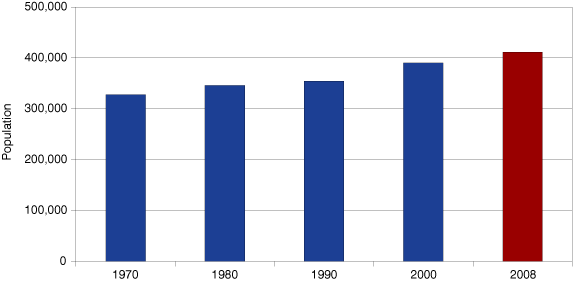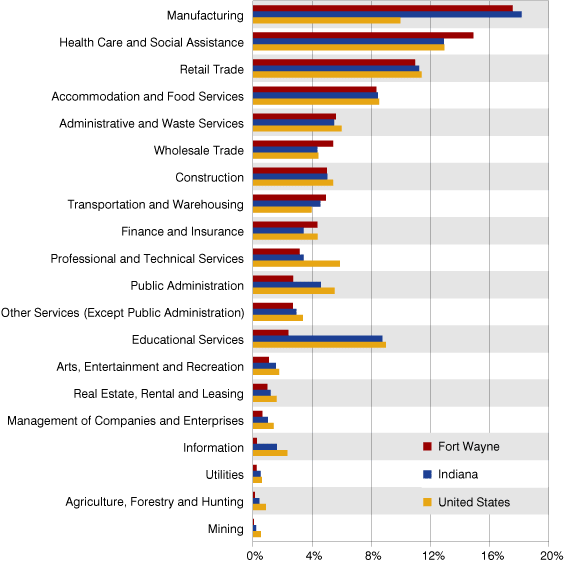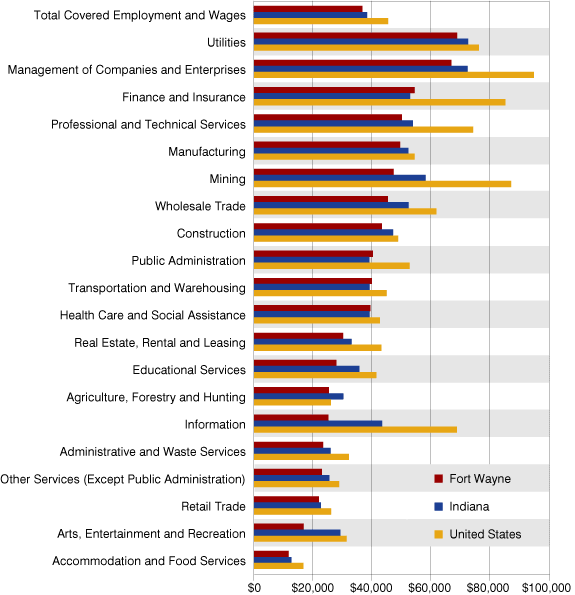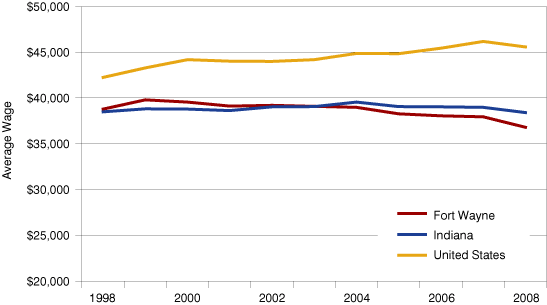The Fort Wayne Metro Story: Told by STATS Indiana
This is the 16th and final article in a series about Indiana’s metropolitan statistical areas (metros). All of the data used in this article can be found using the USA Counties and Metros Side-by-Side feature on STATS Indiana (www.stats.indiana.edu). Because we are using annual data for this series, the information will not reflect some of the recent impacts of the recession.
The Area
The Fort Wayne Metropolitan Statistical Area consists of three counties in northeast Indiana: Allen, Wells and Whitley counties. The Fort Wayne metro had a population exceeding 411,000 in 2008, making up 6.4 percent of Indiana’s total population. Figure 1 shows the Fort Wayne metro’s population since 1970. The metro’s change in population since the turn of the century (5.4 percent) was higher than Indiana’s 4.9 percent growth, but not as fast as the nation’s 8 percent growth from 2000 to 2008.
Figure 1: Fort Wayne Metro Population, 1970 to 2008

Source: IBRC, using U.S. Census Bureau data
The Fort Wayne metro can attribute its population growth to two things in 2008: international migration and natural increase (more births than deaths). Similar to Indiana’s trend, domestic migration was negative, meaning more people moved out of the Fort Wayne metro and to other parts of the United States than moved into the metro. In fact, the metro saw a net domestic migration of -1,761, compared to Indiana’s -1,979.
Jobs and Wages
There were five industries in which the Fort Wayne metro had a higher proportion of workers than the state of Indiana in 2008 and four industries where Fort Wayne had a higher percentage of workers than the nation. Also, there were three industries in which the Fort Wayne metro had a higher proportion of jobs than both the state and nation. They included health care and social assistance (with 14.9 percent of jobs in the metro), wholesale trade (5.4 percent of jobs), and transportation and warehousing (with 4.9 percent of jobs).
Manufacturing had the highest proportion of jobs in the metro at 17.5 percent—lower than Indiana’s 18.2 percent, but still higher than the nation’s 10 percent (see Figure 2). Manufacturing in Fort Wayne had nearly 5,400 more workers than the second place health care and social services industry. Retail trade, the third largest industry in the metro, accounted for 22,330 jobs in 2008, more than 13,000 jobs less than from manufacturing jobs.
Figure 2: Industry Jobs as a Percent of Total Covered Employment, 2008

Source: IBRC, using Bureau of Labor Statistics data
There were no industries in the Fort Wayne metro that paid wages as high as the nation (see Figure 3). The closest industry to achieving the national pay was agriculture, forestry and hunting, paying an average $25,419 per job in 2008 (97.4 percent of the U.S. wage). There were four industries where the Fort Wayne metro paid higher average wages than the state of Indiana: finance and insurance (Fort Wayne paid an average $1,576 more per job than the state), public administration ($1,200 more than the state), transportation and warehousing ($800 more than the state) and health care and social assistance ($213 more than the state).
Figure 3: Average Wage per Job in the Fort Wayne Metro, Indiana and the United States, 2008

Source: IBRC, using Bureau of Labor Statistics data
Of the three industries with the most jobs in the region (manufacturing, health care and social services and retail trade), only manufacturing (in fifth place) ranked among the top five highest average paying sectors in the metro. Health care ranked 11th and retail trade ranked 19th out of the 21 major industry sectors.
Looking at the 10-year change in average wage per job, it appears as though the Fort Wayne metro never fully recovered wages since the last recession (in 2001). In 1999, the Fort Wayne metro annual average wage was $975 higher than Indiana’s. That margin began to shrink1 and by 2004, the state’s annual average wages were higher than Fort Wayne’s and have remained higher since (see Figure 4).
Figure 4: Annual Average Wage per Job in 2008 Dollars, 1998 to 2008

Source: IBRC, using Bureau of Labor Statistics data
Conclusion
The Fort Wayne metro continues to grow, in population at least. Jobs and wages have declined and continue to show an adjustment from a manufacturing-intense economy to a more diverse array of jobs. According to the Indiana Business Review’s 2010 outlook, the Fort Wayne area has been undergoing an economic transformation for years and its ability to recover from the current recession depends on the area’s ability to adapt.2
Notes
- Wages adjusted for inflation to 2008 dollars.
- John Stafford, "Fort Wayne Forecast 2010," Indiana Business Review, Winter 2009, www.ibrc.indiana.edu/ibr/2009/outlook/fortwayne.html.
Molly Manns
Associate Editor, Indiana Business Research Center, Indiana University's Kelley School of Business
